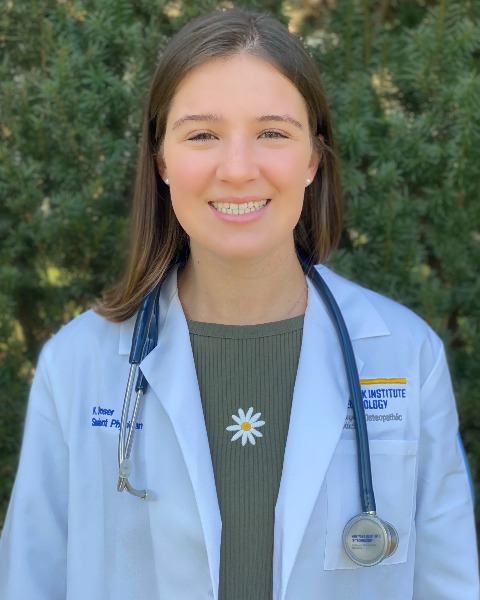Case Report
Program: Section on Integrative Medicine
P2B340: Effects of Osteopathic Manipulative Treatment (OMT) on Functional Impairment in Limb Girdle Muscular Dystrophy Patient: A Case Report
Saturday, October 21, 2023
12:30 PM - 2:30 PM US EDT
Location: Walter E. Washington Convention Center, Exhibit Hall A
Introduction: Limb Girdle Muscular Dystrophy (LGMD) includes a heterogenous group of disorders characterized by progressive wasting and weakness of the proximal limb girdle muscles. Clinical features of diseases include waddling gait, tiptoe walking, difficulty running and climbing stairs, scoliosis, and joint contractures. Treatment of LGMD remains palliative. Physiotherapy and stretching are recommended to delay joint deformities and promote walking. Osteopathic Manipulative Treatment (OMT) is an approach utilized by osteopathic physicians to diagnose and treat musculoskeletal restrictions. It’s based on the principles of human body unity, the body’s ability to regulate and heal itself, the somatic component of disease, and the interrelationship of structure and function. OMT has been shown to be effective in pediatric conditions such as asthma, dysfunctional voiding, infantile colic, otitis media, and postural asymmetry. OMT has been explored in addressing consequences of musculoskeletal dysfunctions in Duchenne Muscular Dystrophy (DMD); however, there is a need for further exploration of OMT in LGMD.
Case Description: An 8-year-old female with LGMD Type 2C (LGMD2C) presents with tiptoe walking, bilateral lower extremity (LE) hypertonicity, and bilateral LE pain. Patient has attempted passive stretching and anti-inflammatory diet with minimal relief. On physical examination (PE), ⅘ strength is present bilaterally in hip flexion/extension, knee flexion/extension, ankle plantarflexion and dorsiflexion. Bilateral calf pseudohypertrophy and decreased range of motion (ROM) in bilateral ankle dorsiflexion and hip flexion was also noted. OMT including myofascial release (MFR), muscle energy technique (MET), balanced ligamentous tension (BLT), and facilitated positional release (FPR) were utilized to treat musculoskeletal restrictions of the lumbar spine, pelvis, sacrum, and lower extremities. Patient received OMT once weekly for a total of four weeks. Immediately post-treatment, pain levels decreased from a 7/10 pre-treatment to a 3/10 post-treatment when walking. After one month, patient reported marked improvement of dorsiflexion and hip flexion ROM, the ability to climb 1 additional flight of stairs with decreased reliance on the crawl method (ie. using both hands and feet), and the ability to walk 2-3 additional blocks without fatigue. Patient also displayed decreased reliance on Gower’s Maneuver when attempting to stand up from a floor-lying position.
Discussion: This case demonstrated improvement in functional impairment in an LGMD2C patient after OMT. Limitations of this study include subjective measurements of pain improvement and daily function. Further studies should include standardized measurements of improvement, such as timed distance trials, joint ROM measurements, or muscle tone readings. Further research needs to be conducted to determine the effect of OMT on LGMD.
Conclusion: This case demonstrated improvement in functional impairment and pain in an LGMD2C patient after receiving OMT. No current research has been found studying OMT in the LGMD population. Further research is needed in order to understand the overall effect of OMT on LGMD.
Case Description: An 8-year-old female with LGMD Type 2C (LGMD2C) presents with tiptoe walking, bilateral lower extremity (LE) hypertonicity, and bilateral LE pain. Patient has attempted passive stretching and anti-inflammatory diet with minimal relief. On physical examination (PE), ⅘ strength is present bilaterally in hip flexion/extension, knee flexion/extension, ankle plantarflexion and dorsiflexion. Bilateral calf pseudohypertrophy and decreased range of motion (ROM) in bilateral ankle dorsiflexion and hip flexion was also noted. OMT including myofascial release (MFR), muscle energy technique (MET), balanced ligamentous tension (BLT), and facilitated positional release (FPR) were utilized to treat musculoskeletal restrictions of the lumbar spine, pelvis, sacrum, and lower extremities. Patient received OMT once weekly for a total of four weeks. Immediately post-treatment, pain levels decreased from a 7/10 pre-treatment to a 3/10 post-treatment when walking. After one month, patient reported marked improvement of dorsiflexion and hip flexion ROM, the ability to climb 1 additional flight of stairs with decreased reliance on the crawl method (ie. using both hands and feet), and the ability to walk 2-3 additional blocks without fatigue. Patient also displayed decreased reliance on Gower’s Maneuver when attempting to stand up from a floor-lying position.
Discussion: This case demonstrated improvement in functional impairment in an LGMD2C patient after OMT. Limitations of this study include subjective measurements of pain improvement and daily function. Further studies should include standardized measurements of improvement, such as timed distance trials, joint ROM measurements, or muscle tone readings. Further research needs to be conducted to determine the effect of OMT on LGMD.
Conclusion: This case demonstrated improvement in functional impairment and pain in an LGMD2C patient after receiving OMT. No current research has been found studying OMT in the LGMD population. Further research is needed in order to understand the overall effect of OMT on LGMD.

Kaitlin M. Unser (she/her/hers)
NYITCOM
Smithtown, New York- SY
Sheldon Yao, n/a
Doctor of Osteopathy (DO)
NYITCOM
Old Westbury, New York

.png)
